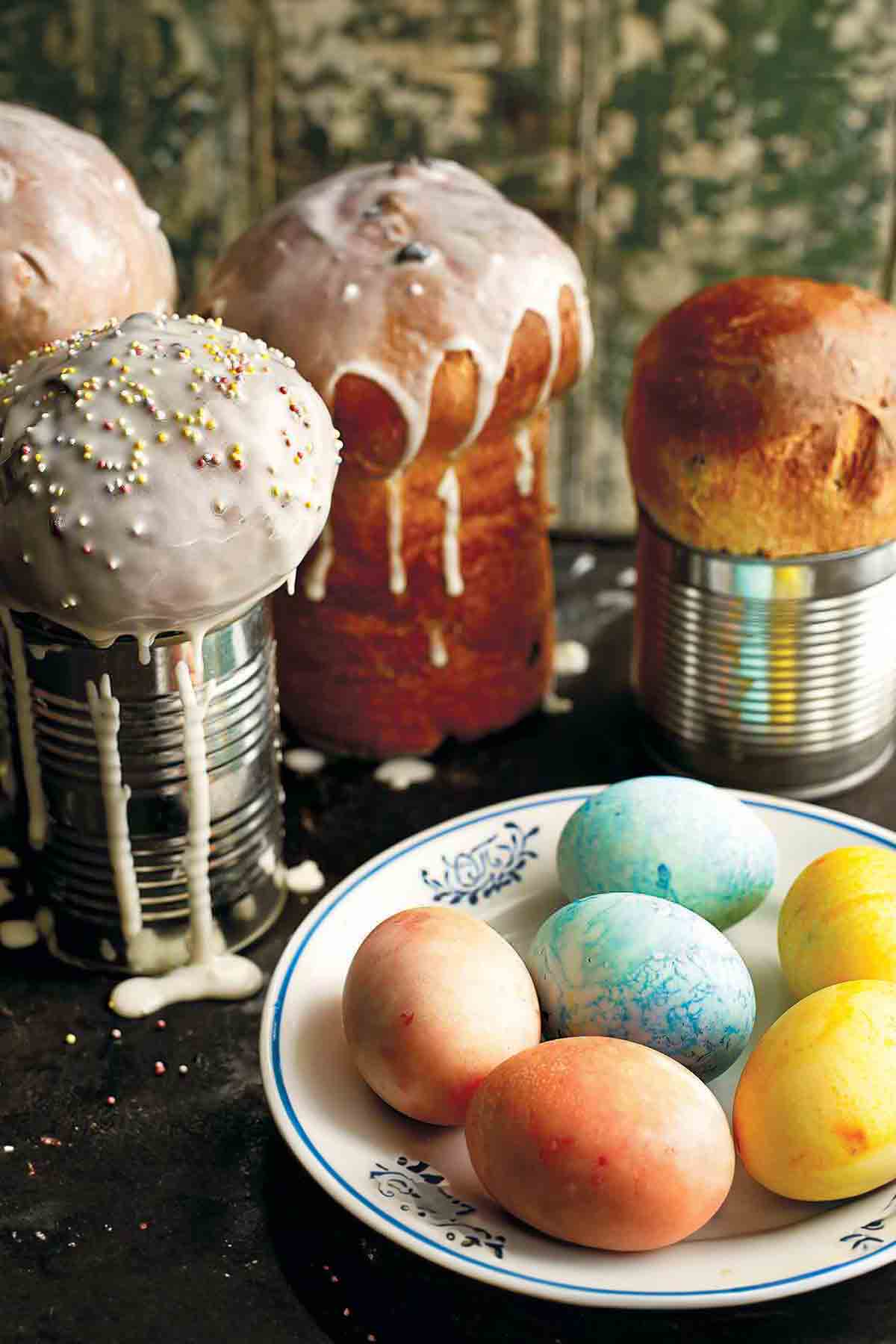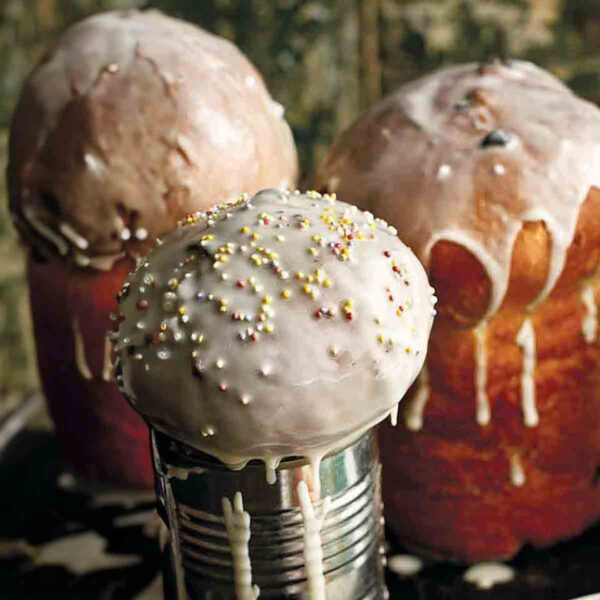
Sometimes called kulich, but we call it paska in the south, this is a slightly bonkers cousin of the Italian panettone, which I cook in cleaned-out tomato tins. Don’t be put off by the 12‑hour proving for the mashed potato starter – it adds a beautiful texture. We make A LOT of these during Easter, which is our biggest religious holiday.–Olia Hercules
Ukrainian Easter Bread FAQs
Paska and kulich are simply different names for the popular Eastern European Easter bread. Both are made with eggs, sugar, and flour, and are often topped with a sweet glaze. Generally, the bread is called paska in Ukraine and other Eastern European countries, and kulich in Russia.
Paska can be enjoyed on its own or topped with a schmear of butter, jam, or honey.

Ukrainian Easter Bread ~ Paska
Equipment
- Four (28 oz or 795 ml) empty tomato cans, cleaned and dried
Ingredients
For the starter
- 3 Russet potatoes, peeled and chopped
- 1 quart water
- 3 tablespoons all-purpose flour
For the dough
- 1 cup warm whole milk
- One (1/2 oz) cake fresh yeast or 2 teaspoons active dry yeast
- 4 large egg yolks, at room temperature
- 2/3 cup superfine sugar (or blitz granulated sugar in a food processor until finely ground)
- 1/2 teaspoon table salt
- 5 to 6 cups all-purpose flour
- Sunflower oil, for oiling
- 1/2 cup golden raisins
For the glaze
- 1 1/2 cups confectioners’ sugar
- 2 teaspoons vanilla extract
- 2 tablespoons water
- Sprinkles, to decorate (optional)
Instructions
Make the starter
- Place the potatoes in a large saucepan, cover with the water, and bring to a boil. Cook until soft, about 15 minutes.
- Reserve 3/4 cup (180 ml) of the cooking liquid, then drain the potatoes in a colander. Return the potatoes and reserved liquid to the saucepan and mash until smooth.
- Add the flour and mix well, then cover and leave in a warm place for 12 hours.
Make the dough
- Add the milk (make sure it’s warm but not hot) and the yeast to the starter and mix well. (If you’re using active dry yeast, let the yeast sit in the milk until foamy, about 5 minutes.)
- In a large bowl, use a handheld mixer to beat the egg yolks with the sugar until slightly thickened, 3 to 4 minutes.
- Fold the milk and yeast mixture into the egg mixture along with the salt. Gradually sift in and mix in the flour – the dough should be firm but bouncy. Cover the dough with a clean kitchen towel and leave to rise in a warm place until doubled in size, 1 to 2 hours.
- Moisten your hands with some sunflower oil and knead the dough for about 15 minutes. Scatter the golden raisins on your work surface and knead them into the dough.
- Now divide the dough into 4 pieces. Oil four clean tomato cans and half-fill them with the dough. Leave to proof in a warm place until doubled, 45 to 60 minutes.
- Meanwhile, preheat the oven to 350°F (180°C).
- Place the dough-filled cans on a baking sheet and bake on the lowest rack of the oven until golden brown and cooked through to an internal temperature of 195°F (91°C), 35 to 40 minutes.
- Let the breads cool completely in the cans, then run a palette knife (or offset spatula) around the edges to help remove the breads from the cans.
Make the glaze
- Whisk the confectioners’ sugar, vanilla extract, and water together in a bowl, then brush over the top of the breads, letting it drip along the sides. Decorate with sprinkles, if you like.

Nutrition
Nutrition information is automatically calculated, so should only be used as an approximation.
Recipe Testers’ Reviews
I will be using this Ukrainian Easter bread recipe as my go-to recipe for future Easter bread making! A labor of love? A little, but oh, does it give back!
While the paska recipe may look intimidating at first, when broken down into its individual parts, it is very manageable. I prepared the starter, which itself was easy, the evening before and started the dough early the next morning.
The best part, a beautifully moist, slightly dense and very tender crumb, likely due to the addition of the potatoes. Also, because it is not to sweet, a slathering of small batch blueberry jam made a perfect topping when the bread was toasted. The tighter crumb also made it an ideal choice for French toast and of course, my mother’s recipe for homemade maple syrup. Even sliced plain and untoasted the next day, it was so good and held up well dunked in a cup of coffee. Am I obsessed with this Easter Bread? Umm, bread pudding maybe!
I found this Ukrainian Easter bread recipe easy and straight forward to make. I had never made a bread with potato in the starter and was very curious how it would turn out. The dough was tender with a nice richness that was not too heavy. If I were to make it again, I would definitely mash my potatoes a bit more. I think some orange zest might also be nice. I have seen some recipes for paska that contain saffron, which could be my next experiment.
A soft delicate crumb, a scattering of raisins and a lovely glaze make this paska a wonderful Easter treat. These little loaves had a wonderfully browned crust and a dense soft crumb. These were delicious sliced and slather with butter, some jam or honey. They would also be tasty with a spread of cream cheese or a nut butter, oh the possibilities! When iced they are perfect to hand out as a sweet Easter gift. Wrap them up and tie with a pretty ribbon to deliver in your Easter basket. How fun!












Russet potatoes come in a variety of sizes. Any guidance as to what we’re shooting for here?
Mom24, you’re going for a total weight of about 500 grams (18 ounces).
Could you describe how to slice it? Vertical wedges (top to bottom) or sideways slice it? It looks a little narrow to get even portions. Thanks!
Bonnie, you can slice it any way you want, or course, but I’d suggest vertically (top to bottom) in wedges to get some of the icing with each slice.
How would I convert to baking in bread pans as far as time and temperature?
Pat, we didn’t try making it in a bread pan, so it’s hard to say. The temperature would probably be the same, but I can’t say how long it would take to cook. You’d have to go with visual cues (browning) and an internal temperature of at least 195°F.
Hi I used to make this bread in tins, I make them now in small cake tins and it’s the same bake time, I do double check with my instaread thermometer. Happy baking
Wonderful, Giselle. Thank you so much for letting us know.
Hi Giselle, can I ask what size tins you use?
The recipe and photo look amazing so I’ve made the starter and will bake the loaves in the morning. Unlike other starters, I noticed that you don’t add yeast at this point. Judging from the reviews and comments, it’s not necessary but would there be any advantage to putting a touch of instant yeast in the starter? Just wondering …
Irene, it would kickstart the starter, if you will.
Hi. if you’re using a can it should be a 10 oz can or the smallest springform pan, you could make them bigger, I like giving a few away to friends. Happy Easter and Happy Baking
Thanks, Giselle.